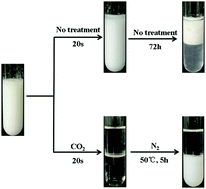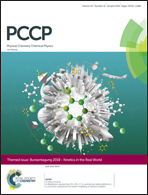Controllable CO2-responsiveness of O/W emulsions by varying the alkane carbon number of a tertiary amine
Abstract
A series of CO2-responsive oil-in-water (O/W) emulsions were prepared by introducing hydrophobic tertiary amines (TAs) with varying alkane carbon numbers (ACNs) into the emulsion stabilized by sodium dodecyl benzene sulfonate (SDBS). TAs are converted to bicarbonate salts upon bubbling of CO2, which can form ion pairs with SDBS via electrostatic interaction, and then disrupt the stability of the emulsion. The reversible switch can be triggered by the removal of CO2. The ACN of TA, the concentration of SDBS/TA, the bubbling time of CO2, and the number of cycles are taken into account in order to study the controllable mechanism of these CO2-responsive emulsions. Because of the improved miscibility with oil, the ion pairs with TAs of larger ACNs can much more easily adhere to the oil phase, and then speed up the rupture rate of the oil droplets. The corresponding demulsification process is tracked by studying the interfacial tension, the zeta potential of the droplets, and microscope snapshots of all the systems. The UV-vis spectrophotometer analysis of the water phase and the 1H-nuclear magnetic resonance (1H NMR) test are further designed to comprehend the significance of ACNs and the solubility product of the formed ion pairs.



 Please wait while we load your content...
Please wait while we load your content...